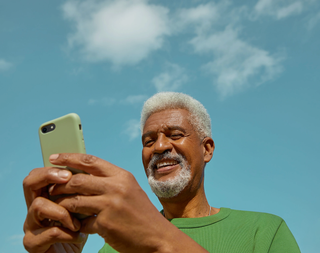Apple announces new accessibility features for Global Accessibility Awareness Day (GAAD)
New accessibility updates from Apple will be released later this year to improve usability for everyone.


What's new?
As part of Global Accessibility Awareness Day, Apple has announced a series of new accessibility features to be released later this year, including a number of new features designed for users who have low vision or are blind. These updates will help improve usability and accessibility across all Apple devices, supporting all users to stay online and connected, because technology should be for everyone.
Magnifier for Mac
Apple’s magnification tool for iPhone and iPad will now allow you to share this display with your Mac computer. This will allow your computer to interact with and control the magnifier tool using the camera of your phone or tablet, making it useful for zooming in on presentations at work or school in real time. Just like with the magnifier feature on your iPhone or iPad currently, the Mac magnifier will also allow you to customise the contrast and colour of your display to improve visibility in a way that’s best for you.
Unfamiliar with your iPhone’s current magnifier? Check out SeeWay’s online iPhone magnifier tutorial to start making the most of your phone today.
Accessibility Reader
Using the new Accessibility Reader, users will be able to reformat text both on their phone and in the real world to make it easier to read. The reader will open the text in a separate window in plain text, where you will be able to make changes to its font, colour, and spacing. Alternatively, you can have the text read aloud to you. The reader will also be built into the Magnifier function, allowing you to easily convert hard to read text from the world around you, such as a menu, to a more accessible format.
Accessibility Nutrition Labels
New Accessibility Nutrition Labels will now be featured with every app in the App Store, helping you to make more informed decisions about which apps will be most accessible to you. These labels will be found underneath the product description and tell you which accessibility features the application is compatible with, such as VoiceOver, larger text, or audio descriptions. It is important to note, however, that the labels will rely on self-nomination by app developers, so standards for compatibility may differ across different creators.
Braille Access
Braille Access will allow braille users to take notes in braille format using a braille device or the Braille Screen Input built into VoiceOver. Braille Access will also support notes in Nemeth Braille, a braille code used for scientific and mathematic calculations, and will be able to open existing files in Braille Ready Format.
Other low vision-friendly features
A few smaller updates were also announced as coming later this year to support users who have low vision or are blind. Apple CarPlay will now support large text, making it easier than ever to follow maps, make calls, and select music.
The Apple Vision Pro, Apple’s augmented reality (AR) headset, will now allow accessibility apps such as Be My Eyes to access its camera, giving users hands free access to guidance and magnification through the headset’s zoom feature.
VoiceOver will be expanded to support the following dialects: Korean, Arabic (Saudi Arabia), Turkish, Italian, Spanish (Latin America), Mandarin Chinese (Taiwan), English (Singapore), and Russian.
Excitingly, these new settings, as well as all the existing settings you might have set up for your device, will now be transferable to other devices. This means if you borrow a friend or family member’s device, you can instantly configure it to the settings that work best for you.The transfer is temporary, so they won’t stay on someone else’s device after you are done using it.
In addition to these low vision-friendly settings, Apple also unveiled a number of other accessibility features to accommodate the diverse needs of all their users, including users who are deaf, hard of hearing, or have limited mobility. While there is no exact date set for the release of these new settings yet, it is great to see the future of technology being guided by improved inclusion and access.
If you’d like support setting up your devices in a way that’s accessible for you, SeeWay is here to help. SeeWay’s digital skills training is available online and in-person for free, to help you stay safe, confident, and connected through your devices.
Did you find this article helpful?
Share your thoughts and help us make our resources better for everyone.
Enjoying the content?
Start building your profile to access personalised support, resources, and tools tailored to your eye health journey.
